Click on images to enlarge
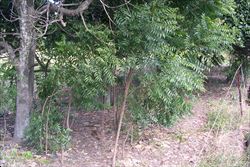
infestation of saplings (Photo: Chris Gardiner)
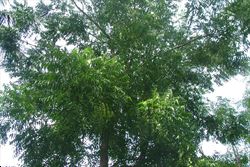
habit (Photo: Sheldon Navie)

sapling (Photo: Sheldon Navie)

bark on main trunk (Photo: Sheldon Navie)
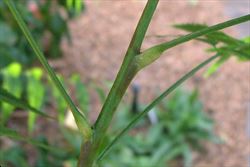
younger stem and leaf stalks (Photo: Sheldon Navie)
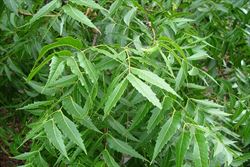
once-compound leaves (Photo: Sheldon Navie)

close-up of sharply-toothed leaflets (Photo: Sheldon Navie)

flower clusters (Photo: Sheldon Navie)
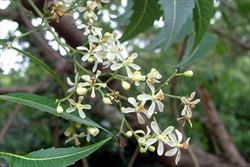
close-up of flowers (Photo: Sheldon Navie)

immature fruit (Photo: Sheldon Navie)

mature fruit (Photo: Chris Gardiner)

close-up of immature fruit and seed (Photo: Chris Gardiner)
Scientific Name
Azadirachta indica A. Juss.
Family
Meliaceae
Common Names
Indian lilac, lilac, lilac plant, lilac tree, margosa, margosa tree, neem, neem plant, neem tree
Origin
The exact native range of this species is obscure, but it is thought to be native to the Indian Sub-continent (i.e. India and Bangladesh) and northern Myanmar.
Naturalised Distribution
This species has recently become naturalised in some parts of northern Australia (i.e. in the coastal districts of northern Western Australia, in the north-western parts of the Northern Territory, and in northern Queensland).
Also naturalised overseas in tropical Asia (e.g. Indonesia), Africa, Fiji, Mauritius, Puerto Rico, the Caribbean and many countries in South and Central America.
Notes
Neem (Azadirachta indica) is regarded as an environmental weed in the Northern Territory, in northern Queensland and in northern Western Australia. It is actively managed by community groups in the Northern Territory and was recently listed as a priority environmental weed in two Natural Resource Management regions in northern Australia. This species has been grown in commercial plantations in the Gilbert and Mareeba areas of Queensland, mainly for its insecticidal properties, and has also been promoted as a street tree in Darwin. It has spread from these cultivated populations into natural environments, mainly as a result of dispersal by birds and bats that eat its fruit. Habitats that are beginning to become infested include shrublands, open woodlands, grasslands, floodplains, riparian zones, coastal sites and other disturbed natural vegetation.
Some of the largest infestations of this species have been reported along the Gilbert River in Queensland, in the Victoria River Downs area in the Northern Territory and along the Ord River in northern West Australia. An infestation in a paddock beside the Gilbert River, west of Georgetown, was recently reported to be covering tens of hectares. In the Townsville area, neem (Azadirachta indica) is appearing in numerous riparian and revegetation sites and its seedlings have been noted to be germinating and growing in dense shade. Riparian zones in drier tropical regions seem to be most at risk from invasion, but coastal bushland is also under threat from this species. For example, beach environs in the Darwin region are becoming increasingly infested with this species. There is also concern over the potential impact of this plant on native insect populations, and there is evidence that extracts from neem (Azadirachta indica) can affect certain aquatic wildlife including fish and tadpoles.

